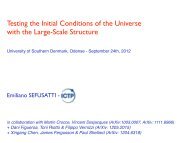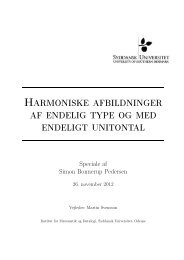A high-resolution version for printing - CP3-Origins
A high-resolution version for printing - CP3-Origins
A high-resolution version for printing - CP3-Origins
You also want an ePaper? Increase the reach of your titles
YUMPU automatically turns print PDFs into web optimized ePapers that Google loves.
Sustainability is the key <strong>for</strong> success, and this is why we will provide several permanent positions<br />
in particle physics. This demonstrates strong commitment to the field in Denmark. Several<br />
young researchers and graduate students will have the opportunity of receiving a <strong>high</strong>ly<br />
qualified training while being themselves fundamental<br />
component of the centre's scientific life.<br />
The convergence of its near to perfect timing, outstanding<br />
team, and unprecedented support at the University of<br />
Southern Denmark (SDU) means that CP³-<strong>Origins</strong> is<br />
acutely primed to raise Danish research to the very top of<br />
the international field of particle physics.<br />
The Need to Go Beyond<br />
The energy scale at which the LHC experiment will operate is<br />
determined by the need to complete the standard model (SM) of particle interactions and, in<br />
particular, to understand the origin of mass of the elementary particles. Together with classical<br />
general relativity the SM constitutes one of the most successful models of nature. We shall,<br />
however, argue that experimental results and theoretical arguments call <strong>for</strong> a more fundamental<br />
description of nature. The SM can be viewed as a low-energy effective theory valid up to an energy<br />
scale Λ. Above this scale new interactions, symmetries, extra dimensional worlds or any<br />
other extension could emerge. At sufficiently low energies with respect to this scale one expresses<br />
the existence of new physics via effective operators. The success of the SM is due to the<br />
fact that most of the corrections to its physical observables depend only logarithmically on this<br />
scale. In fact, in the SM there exists only one operator which acquires corrections quadratic in Λ.<br />
This is the squared mass operator of the Higgs boson. Since Λ is expected to be the <strong>high</strong>est possible<br />
scale, which in four dimensions corresponds to the Planck scale, it is hard to explain naturally<br />
why the mass of the Higgs is of the order of the electroweak scale. This is the hierarchy<br />
problem. Due to the occurrence of quadratic corrections in the cutoff scale Λ this SM sector is<br />
most sensitive to the existence of new physics. Many questions need an answer even if the<br />
Higgs is found at the LHC: Is it composite? How many Higgs fields are there in nature? Are<br />
there hidden sectors?<br />
Nature’s Riddles<br />
Why do we expect that there is new physics awaiting to be discovered? Of course, we still have<br />
to observe the Higgs boson. However, even with the Higgs discovered, the SM has both conceptual<br />
problems and phenomenological shortcomings. In fact, theoretical arguments indicate that<br />
the SM is not the ultimate description of nature:<br />
Hierarchy Problem: The Higgs sector is <strong>high</strong>ly fine-tuned. We have no natural separation between<br />
the Planck and the electroweak scale.<br />
Strong CP Problem: There is no natural explanation <strong>for</strong> the smallness of the electric dipole moment<br />
of the neutron within the SM. This problem is also known as the strong CP problem.<br />
Origin of Patterns: The SM can fit, but cannot explain the number of matter generations and their<br />
mass texture.<br />
CP³-Black book 2








